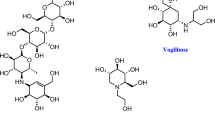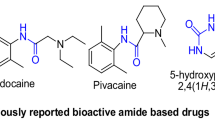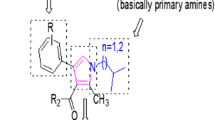Abstract
α-Amylase and α-Glucosidase are important therapeutic targets for type II diabetes. The present focus of our study is to elucidate the hypoglycemic activity of novel compounds through in vitro and in silico studies. Here, we synthesized the nitro acridines (3a–3c), amino acridines (4a–4c), and nitro phenylquinoline (3d) and amino phenylquinoline (4d) using a multi-step reaction protocol in good yields. All the above derivatives were screened for molecular docking, α-Amylase and α-Glucosidase inhibitory activities utilizing acarbose as standard drug. In silico studies were performed to explore the binding ability of compounds with the active site of α-Amylase and α-Glucosidase enzymes. The in vitro antihyperglycemic report of 3c exhibits the maximum inhibitory activity with IC50 values of 200.61 ± 9.71 μmol/mL and 197.76 ± 8.22 μmol/mL against α-Amylase and α-Glucosidase, respectively. Similarly, the compound 3a exhibits IC50 values of 243.78 ± 13.25 μmol/mL and 296.57 ± 10.66 μmol/mL, and 4c exhibits IC50 values of 304.28 ± 3.51 μmol/mL and 278.86 ± 3.24 μmol/mL with a significant p < 0.05 in both enzyme inhibitions. In addition, the presence of diverse functional moieties in synthesized compounds may provide a strong inhibitory action against the abovementioned enzymes compared with standard acarbose inhibition (IC50, 58.74 ± 3.68 μmol/mL and 49.39 ± 4.94 μmol/mL). Also, the docking studies provided an excellent support for our in vitro studies. The outcome of these studies recommends that the tested compounds might be treated as potential inhibitors for the starch hydrolyzing enzymes in type II diabetes.






Similar content being viewed by others
References
Palanuvej C, Hokputsa S, Tunsaringkarn T, Ruangrungsi N (2009). Sci Pharm 77(4):837
Chang LS, Li CB, Qin N, Jin MN, Duan HQ (2012). Chem Biodivers 9(1):162
Ditzel J, Lervang HH (2009). Diabetes, Metabolic Syndrome and Obesity: Targets and Therapy 2:173
Sales PM, Souza PM, Simeoni LA, Magalhães PO, Silveira D, Pharm J (2012). Pharm Sci 15:141–183
Lebovitz HE (1998). Diabetes Rev 6:132–145
Tundis R, Loizzo MR, Menichini F (2010). Med Chem 10:315–331
Sondhi SM, Singh J, Rani R, Gupta PP, Agrawal SK, Saxena AK (2010). Eur J Med Chem 45:555–563
Gupta SK (2004). Drug screening methods (Pre clinical evaluation of new drugs) 2nd edn. Jaypee Medical Publishers (P) Ltd, New Delhi, pp 306–309
Korth C, May BC, Cohen FE, Prusiner SB (2001). Proc Natl Acad Sci U S A 98:9836–9841
Temple MD, McFadyen WD, Holmes RJ, Denny WA, Murray V (2000). Biochemistry. 39:5593–5599
Riera X, Moreno V, Noe V, Font-Bardía M, Solans X (2007). Bioinorg Chem Appl:98732 https://doi.org/10.1155/2007/98732
Jiang D, Tam AB, Alagappan M, Hay MP, Gupta A, Kozak MM, Le QT (2016). Mol Cancer Them 15:2055–2065
Cholewiński G, Dzierzbicka K, Kołodziejczyk AM (2011). Pharmacol Rep 63:305–336
Pang X, Chen C, Su X, Li M, Wen L (2014). Org Lett 16:6228–6231
Peacocke AR, Nicholson BH, Dean ACR, Clayson DB, Henry DW (1973) Heterocycl. Compd. John Wiley, New York, p 723
Ketron AC, Denny WA, Graves DE, Osheroff N (2012). Biochemistry. 51:1730–1739
Amuthalakshmi S, Smith AA (2013). Adv Biol Res 7:248–252
Kubinyi H (1998). Curr Opin Drug Discov Devel 1:16–27
Levetan C (2007). Curr Med Res Opin 23:945–952
Rajesh YB (2018). Quinoline Heterocycles: synthesis and bioactivity In heterocycles-synthesis and biological activities. Intechopen.com. https://doi.org/10.5772/intechopen.81239
Hansawasdi C, Kawabata J, Kasai T (2000). Biosci Biotechnol Biochem 64:1041–1043
Kim YM, Jeong YK, Wang MH, Lee WY, Rhee HI (2005). Nutrition. 21:756–761
Li AP (2001). Drug Discov Today 6:357–366
Lipinski CA (2000). J Pharmacol Toxicol Methods 44:235–249
Sugiyama Y (2005). Drug Discov Today 10:1577–1579
Lipinski CA, Lombardo F, Dominy BW, Feeney PJ (2012). Adv Drug Deliv Rev 64:4–17
Agoram B, Woltosz WS, Bolger MB (2001). Adv Drug Deliv Rev 50:S41–S67
Cheemanapalli S, Anuradha CM, Madhusudhana P, Mahesh M, Raghavendra PB, Kumar CS (2016). Anti Cancer Agents Med Chem 16:1496–1510
Acknowledgments
The authors are grateful to the VIT University in Vellore, India, for giving facilities to convey explore work. The authors are likewise appreciative to the Department of Biotechnology, School of Herbal Studies, and Nature Sciences in Dravidian University, Kuppam, India.
Author information
Authors and Affiliations
Corresponding author
Ethics declarations
Conflict of interest
The authors declare that they have no conflict of interest
Additional information
Publisher’s note
Springer Nature remains neutral with regard to jurisdictional claims in published maps and institutional affiliations.
Electronic supplementary material
ESM 1
(DOCX 1823 kb)
Rights and permissions
About this article
Cite this article
Narayanaswamy, L., Yarrappagaari, S., Cheemanapallia, S. et al. Synthesis, characterization, and hypoglycemic efficacy of nitro and amino acridines and 4-phenylquinoline on starch hydrolyzing compounds: an in silico and in vitro study. Struct Chem 31, 2063–2074 (2020). https://doi.org/10.1007/s11224-020-01529-5
Received:
Accepted:
Published:
Issue Date:
DOI: https://doi.org/10.1007/s11224-020-01529-5




